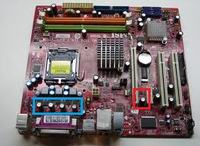Hello. First of all, sorry if this is in the wrong section, but I'm not on here very often. I'm also not a computer scientist, so I don't know if everything will be understandable.
My problem is that on my mother-in-law's computer the motherboard has failed. I deduced this from the fact that 4 capacitors are swollen. Two hard drives were connected to the computer. Unfortunately, one has the system (Vista) and files that are priceless for my mother-in-law. In fact, on the second one there are also priceless files that cannot be touched
the motherboard has failed. I deduced this from the fact that 4 capacitors are swollen. Two hard drives were connected to the computer. Unfortunately, one has the system (Vista) and files that are priceless for my mother-in-law. In fact, on the second one there are also priceless files that cannot be touched  The point is that I want to put in another motherboard with a different processor, which doesn't seem difficult because the frames and other components are coming, but I don't have another disk and I have to keep these files. Here the question arises: "how to do it?".
The point is that I want to put in another motherboard with a different processor, which doesn't seem difficult because the frames and other components are coming, but I don't have another disk and I have to keep these files. Here the question arises: "how to do it?".
As I wrote, I'm not an IT specialist, but I can easily put together a computer and install a new system, but I don't know how to start this topic. Can it be done at all? Please help. After all, it's about the mother-in-law
My problem is that on my mother-in-law's computer
As I wrote, I'm not an IT specialist, but I can easily put together a computer and install a new system, but I don't know how to start this topic. Can it be done at all? Please help. After all, it's about the mother-in-law



